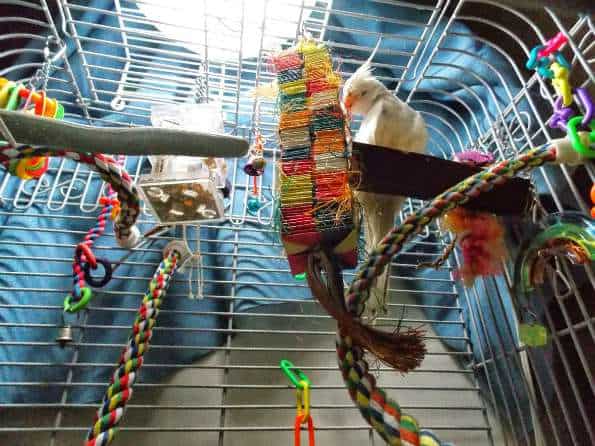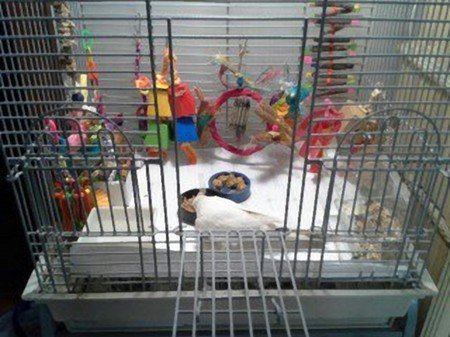Last Updated on by Mitch Rezman
Cooler days and colder nights ~ Forewarned is forearmed
Ready to have the whole fam damily sit in front of the fireplace for the first time this year and watch a movie on Netflix?
It would only be right to have your precious little bundle of feathers in the room to enjoy the family bonding time too.
So before you fire things up, did you poke your head inside the fireplace and look up the chimney to make sure that the vent is open?
Did you look for any creosote or soot buildup that may prevent, oh I don’t know, stuff that’s poisonous to your bird from getting blown out of your chimney?
Cheapskate that you are, you finally give in to the Mrs. to “kick up the heat a couple of degrees” for the first time this year.
That first blast of warm air coming out of your furnace ducts has a possibility of spewing all sorts of mold and dust spores which I’m going to go out on a limb and say could possibly negatively impact your bird’s respiratory system – you’ve been warned.
So take a look and get it done now.
Don’t get me started on how the changing light cycle will impact your birds hormones. I’m going to advocate that you learn a little about birds and full spectrum lighting.
Costco and bird play stands
So we close the shop, drop Popcorn off at the apartment and begin the arduous journey north on Western Avenue (the street that the Birdie Boutique is on which is the longest continuous street in the world if you’re new to the blog) on our way to Costco to get a plush blanket I had my eye on. There was one for $16 but we upgraded to a better quality one for $25 and it’s to die for or so Catherine says.
Oh and my point? What does a married couple talk about in the car while stuck in city traffic? Apparently, bird play stands became the subject in play. Catherine with laser focused clarity spoke of why you really don’t need any feeder dishes on a play stand.
Wait – memo to self, please reply to all of the caged bird keepers that have written seeking a bird play stand that will keep a bird from getting to the floor, with the following “they’re birds, get over it.”
The primary purpose of a bird play stand is to have a place to put the bird when out of the cage.
Place an umbrella cockatoo on the back of a chair regardless of the material including Superman’s cape, it will get destroyed. Who’s fault is that? Not the bird’s.
It’s only OK to put a macaw on a chair if you have a monkey to distract it from chewing the chair into slivers

Why then do you ask that I advocate being mean by not granting your bird instant access to a never-ending supply of food and water on their play stand?
That’s because you want them to go back to the birdcage at some point where the food and water are. Are you really seeking to expand your vacuuming radius across the room?
By filling the feeder cups on a playstand with food, you may be offering your bird the equivalent of a daily Starbucks Venti White Chocolate Blended Creme Frappuccino (without whipped cream) that’s 630 calories and 9g of fat. Hold it here for a moment. You weighed your bird recently right?
You know it is in perfect health because its weight hasn’t changed significantly in the past 30 days right?
Please don’t tell me you are relying on the last well visit to your vet, 10 months ago? It’s such a simple and easy tool for caged bird care.
When your bird is out of the cage it’s time to be active. Do things, explore things, interact with its environment and humans around it. Do I hear whining about those really cool colored dishes on the play stand and how they shouldn’t go unused?
Alternative to filling cups with food and treats
You’re right – so as Catherine said, “Fill the bird cage feeder dishes with bird toys. Your bird will thank you for that”.
Bell
I’m a little perplexed. My boyfriend raised Bell. For the first 14 years of his life, Bell really didn’t get any attention, learn to speak, toys, etc. Steve isn’t mean, he was just clueless. So was I.
When Steve started working longer hours, I took over Bell because I work at home.
It took me 3 months for Bell to get connected to me – and another year for us to really get close.
That was 4 years ago. We always thought Bell was just a low-key, chill bird. He liked his one toy. I wanted to keep him happy, so I was careful to keep everything the same. Then I started reading your newsletter.
Since then I’ve introduced a bunch of new stuff a bit at a time. He is really really afraid of new things.
And his cages – one at my house, one at Steve’s needs more hanging stuff. But even though I introduce them slowly, with positive feedback, put avi-cake on them, etc, he still stays wary.
We used to think he doesn’t like toys; now, I know he doesn’t KNOW toys. Or bird behavior.
Mango learns from kiwi – but who will show Bell? And he doesn’t like baths because he used to only take one once a month. I mist him saying good boy! You’re a pretty bird while I do it, but he still hates it.
Here’s the issue – he has seriously severe arthritis (I go to an avian vet – actually Dr. Thielen who’s on that reality TV show – Dr K’s exotic vets in FL, but Dr Thielen actually is in a practice in Bedford Hills, NY) and she saw him walk and diagnosed him, confirmed with an ex-ray. I feed him a bit of “birdie Aleve” in a syringe every day.
Apparently, it’s a catch-22. Sitting causes it, but the pain (plus unfamiliarity with how to be a bird) doesn’t exactly foster movement.
I belong to the Quaker Parrots group on Facebook and am fascinated by the huge set ups some of them have and have begun plans to slowly build something like that in the corner of my small apt, starting with bringing some driftwood home from SC this week when I visit there.
I’d send you pics of his cage, but I don’t have an iPhone. But I’m sure you wouldn’t like them now.
Lots of perches, but very few toys. I really don’t have a treatment plan or a clue how to help Bell. Is it as simple as one toy at a time, keeping it by the cage, playing with it to show it’s safe, introducing it into the cage, and then starting over with a new one?
I don’t want to freak him out, but he needs to stop sitting on his same perch all the time with his one toy. It’s terribly important to me that he be a safe, happy, healthy bird.
And I’m so glad I started reading your newsletter, or I’d never have known – I’d just have kept doing the same thing with the right intent, but the wrong action. Thank you. Judi
Hey Judi
Thank you for being an advocate for Bell.
First please remember “The less change a bird experiences in its environment the more resistant to change a bird is going to be”.
Your vet’s diagnosis is of no surprise. The organic knowledge base we’ve developed from interactions with tens (hundreds?) of thousands of caged bird keepers over two decades has convinced us that we have raised a generation of caged birds with arthritic feet.
Let’s not get ahead of ourselves. Many caged bird keepers in spite of the length of relationships they have with their bird don’t understand how a bird’s foot works. This is really important because unless in flight, birds are on their feet 24/7.
Most people are surprised to learn that birds have no muscles in their legs nor their feet just a pair of tendons called Flexor tendons that run basically from the hips to the toes. It’s an extraordinarily elegant and efficient system and you can read more about that here,
We’ve done the math. A bird who sleeps 12 hours a night on the same perch for 15 years will spend 50,000 hours on that perch – this 50,000 hours gripping the same perch – yikes!
Not knowing how severe his arthritis is I’m going to err on the side of caution and tell you to make some radical changes to Bell’s cage. it’s important to note that a bird’s strongest defense is not to allow the world to see that they are physically compromised in any way.
It may be that Bell has learned to live with this pain and although the medication you are giving him daily will be reducing it, we will try to improve his quality of life.
We performed this drill ourselves when our fat little Cockatiel Popcorn injured her leg from bouncing around the cage too much while being overweight. She actually ended up being put in a cast by our vet.
Her cage went from this

to this in the time it took for me to drive home from the vet’s office.

At the end of the day lowering everything to the floor of the cage proved to be effective therapy to help her help herself heal her injuries. You want to discourage climbing up cage walls. Think about using flat ladders as gateways
Something else you might want to consider for your quaker is getting a gazillion coffee stir sticks and give him a corner of your apartment to build this.
Who knows it might take his mind off the pain.
And then take a look at this category (yep it comes to sales pitch) there’s a reason that we offer a number of flat perches with our offerings growing we can find new products.
Our single most popular perches is becoming our Manzanita flat perch. Bell would love one
BTW – We don’t recommend driftwood for birds as it can contain toxins, heavy metals, excess salt and who knows what from floating around in the ocean for a long time.
Do bird’s feet hurt?
Aglae Wrote :
Does the wire platform on the bottom of the cage hurt my bird? It seems uncomfortable to me. Should I throw it out? Maybe you
can explain why all the cages have them. Thank you, Aglae
Aglae, Unless in flight, birds are their feet 24/7. Actually it’s the best surface for a parrots foot.
Water birds like seagulls have web or flat feet which is why you’ll see seagulls on the top of street lamps and not on phone wires.
Birds like parrots or pigeons need to wrap they feet “around” branches perches or cage grates (or phone lines) so as to get a better grip.
Birds have very few nerves in their feet enabling them to stand on even thorny or rough objects except when they are in flight.
A tendon on the side of a bird leg locks a birds foot around a perch enabling them to sleep standing up. Because of the lack of nerves in their feet, they feel little or no discomfort.
The grate in a cage lets the refuse a bird leaves, fall though to bottom where a tray can be removed for easy cleaning. Regards,
mitchr
Food/water bowls for my cockatiels?
Hi! Could you please send me recommendations for food/water bowls for my cockatiels?
I would like to purchase some that have holders that won’t rust. Due to my vet’s advice, I have to add cherry juice to one of my tiel’s water because she has high uric acids levels << gout.
It is rusting her bowl holder.
I’m not sure how long I may have to continue this so I need some good, sturdy bowls. I love your products & enjoy shopping at your store! Want to let you know also that I adore your Sunday Birdie Brunch that send through email! 🙂 Love your store! 🙂 Thanks so much for your help!!! 🙂 Lyn
Hi Lyn
Any of the stainless steel dishes on this page should suffice it’s difficult to recommend a particular one without seeing your cage set up. We also have a good selection of plastic dishes and crocks that won’t have any issues with the acidic nature of the cherry juice.
I hope your vet recommended some diet changes – Gout, much like feather plucking is all but nonexistent in the wild. The lack of understanding what causes gout can put your pet bird at risk.
I’m not even going to try to wing it. Ron Hines DVM PhD wrote an exceptional article entitled What Is Gout In Birds?
Some takeaways you’ll get are:
- Gout occurs in birds when uric acid levels become too high in their blood stream. All birds form uric acid and urate salts as a way of cleansing their bodies of the nitrogen-containing wastes that accumulate as they utilize the proteins in their foods.
- Any kind of pet bird can develop gout. Traditionally, veterinarians saw the problem, most often in budgies, cockatiels and canaries – birds that consume little water. But as larger pet hook-bills have become more commonplace, we see more gout in them as well.
- Many informed parrot owners encourage their pets to consume fruit. That is good. But market fruits tend to be much higher in fructose sugar than jungle fruit. Vegetables are more important than fruit in most birds diets.
This article is about 8000 words which is approximately four times the length of this article. I highly advocate that you read it through over time to help develop a more positive outcome nutritionally for your birds.
Best of luck with your Tiel
mitchr
What food do you recommend for a derbyan parakeet?
editor’s note: To those outside of caged bird keeping the term parakeet inevitably conjures up the picture of a budgie. We know there are actually about 370 species of parakeets. I love exploring them all…..mitch
Medium parrot food? Or should I feed more grain and seed since the derbyan is a type of parakeet and not a tropical parrot?
they are sexually dimorphic – Male Derbyans have a red upper mandible
with a yellow tip, while the lower mandible is black. The females have an all-black beak.
Hi Myra
Not all parrots are parakeets but all parakeets are parrots. A Derbyan (aka Lord Derby’s Parakeet) is called a Parakeet because of its long tail, like an Indian Ringneck parakeet.
A large Parakeet like a Derbyan would likely enjoy a medium to small bird food. Small meaning like for conures, caiques. Not real small like Budgerigars or Cockatiels. The Derbyn may also enjoy some larger chunks of food in some medium bird food mixes as well like for small greys, small amazons, etc.
Is your bird eating pellets or a seed mix? If pellets the Hagen Parrot Granules are a nice size.
The Higgins Intune pellets in either the Conure size or the larger Parrot size, it all depends on what size pellets your bird enjoys. I would recommend trying the smaller Conure variety first.
The Intune pellets are in all of the Higgins seed mixes. I would recommend the Sunburst Conure mix to start.
I hope this helps. Please let me know if you have further questions.
Thank you, Catherine
Author Profile
Latest entries
 The Traveling BirdJune 26, 2025Can You Name 5 Parrot Species That Are Living Wild in the USA?
The Traveling BirdJune 26, 2025Can You Name 5 Parrot Species That Are Living Wild in the USA? Bird BehaviorJune 26, 2025How is it Parrots Are Problem Solvers Social Animals and Even Use Tools?
Bird BehaviorJune 26, 2025How is it Parrots Are Problem Solvers Social Animals and Even Use Tools? Bird & Parrot AnatomyJune 25, 2025How a Tiny Chemical Modification Makes Parrots Nature’s Living Paintings
Bird & Parrot AnatomyJune 25, 2025How a Tiny Chemical Modification Makes Parrots Nature’s Living Paintings PigeonsJune 20, 2025How Do Parrots Thrive in Cities Outside Their Native Habitats?
PigeonsJune 20, 2025How Do Parrots Thrive in Cities Outside Their Native Habitats?




